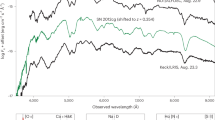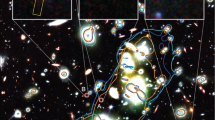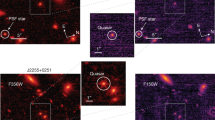Abstract
The ‘triple’ quasar, PG1115 +08 (which actually contains at least four objects: A1, A2, B and C) was the second gravitational lens object to be found1. But because of its small angular scale (<2.5 arc s separation between components) and lack of detectable radio emission, which precludes the use of high-resolution interferometric radio techniques, not much is known about this object. In particular, the lensing object(s) have not been identified. Here we report imaging observations made on a night of exceptional seeing, as well as spectroscopy of two galaxies near the quasar. We find that there is a galaxy centred approximately midway between the two A components. The properties of this galaxy are consistent with it being the brightest member of a small group at a group redshift of 0.305. Although detailed modelling is required, it is likely that the galaxy and its group are the lenses.
This is a preview of subscription content, access via your institution
Access options
Subscribe to this journal
Receive 51 print issues and online access
$199.00 per year
only $3.90 per issue
Buy this article
- Purchase on Springer Link
- Instant access to full article PDF
Prices may be subject to local taxes which are calculated during checkout
Similar content being viewed by others
References
Weyman, R. J. et al.. Nature 285, 641–643 (1980).
Young, P. et al. Astrophys. J. 244, 723–735 (1981).
Hege, E. K., Angel, R. P., Weyman, R. J. & Hubbard, E. N. Nature 287, 416–417 (1980).
Vanderriest, C. et al. in Quasars and Gravitational Lenses, Proc. 24th Liege astrophys. Colloq. (1983).
Hege, E. K., Hubbard, E. N., Strittmater, P. A. & Worden, S. P. Astrophys. J. Lett. 248, L1–L3 (1981).
Foy, R., Bonneau, D. & Blazit, A. Astr. Astrophys. 149, L13–L16 (1985).
King, I. R. Publs astr. Soc. Pacif. 83, 199–201 (1971).
King, I. R. Astr. J. 71, 64–75 (1966).
Heasley, J. N. Publs. astr. Soc. Pacif. 96, 767–772 (1985).
Schweizer, F. Astrophys. J. 233, 23–34 (1979).
Narasimha, D., Subramanian, K. & Chitre, S. M. Mon. Not. R. astr. Soc. 200, 941–950 (1982).
Shaklan & Hege, E. K. Preprint no. 609, Steward Observatory, Tucson, Arizona.
Boroson, T. Astrophys. J. Suppl. Ser. 46, 177–209 (1981).
Kormedy, J. Astrophys. J. 218, 333–346 (1977).
Author information
Authors and Affiliations
Rights and permissions
About this article
Cite this article
Henry, J., Heasley, J. High-resolution imaging from Mauna Kea: the triple quasar in 0.3-arc s seeing. Nature 321, 139–142 (1986). https://doi.org/10.1038/321139a0
Received:
Accepted:
Issue Date:
DOI: https://doi.org/10.1038/321139a0
Comments
By submitting a comment you agree to abide by our Terms and Community Guidelines. If you find something abusive or that does not comply with our terms or guidelines please flag it as inappropriate.



